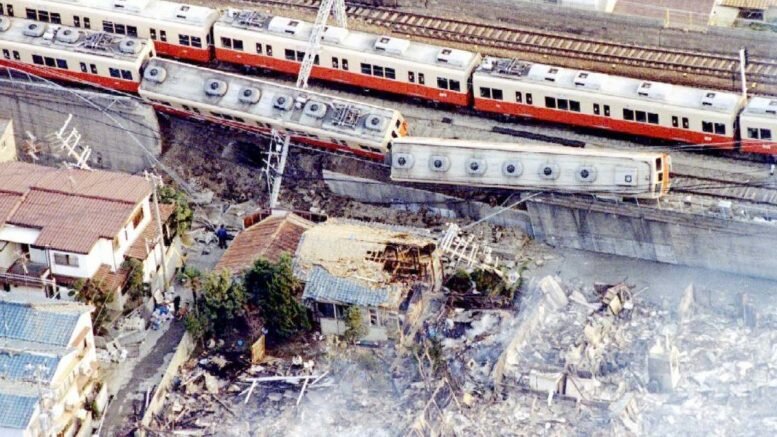Norway lies far from any tectonic plate boundaries. Why do earthquakes happen and what are the most powerful earthquakes to hit Norway?
The most destructive earthquakes take place at plate tectonic boundaries.
This is where one tectonic plate sinks below another, such as the east coast of Japan, or where two tectonic plates slide past one another, such as along the San Andreas fault in California, USA.
Norway is far from tectonic plate boundaries, and yet earthquakes have shaken the ground and damaged Norwegian communities.
Read on to find out about some of the most powerful earthquakes to have hit Norway, and why.
What is an earthquake?
Tectonic plates move on average only a few millimeters per year. This gradual motion builds stress on smaller faults and fractures.
Sudden movements along faults can occur at meters per second, releasing large amounts of energy in the form of seismic waves.
An earthquake epicenter is the location of the fault movement.
Seismic waves cause the shaking motion that is so characteristic of earthquakes. The first waves to arrive compress the ground, while the second waves displace the ground laterally in a swaying motion.
Most of the buildings in our cities are not capable of withstanding the swaying motion caused by passing seismic waves.
Measuring the power of the shaking
Each earthquake releases seismic waves of different amplitudes. The logarithm of the wave amplitude gives the earthquake a magnitude.
Earthquake magnitudes range from 0 to 9 on the Richter scale. Most earthquakes in Norway have a magnitude less than 5 on the Richter scale.
Only a few earthquakes had magnitudes greater than 5 and even fewer greater than 6. Where do these powerful earthquakes occur and should we be worried?
Where do the most powerful earthquakes occur in Norway?
Most earthquakes in Norway have an epicenter off the western coast in the North Sea and the Arctic Ocean.
To the west of Norway, about halfway to Greenland, is the mid-oceanic ridge. Here, two tectonic plates move apart to create new crust.
Earthquakes with magnitudes larger than 4 occur directly along the mid-oceanic ridge.
Earthquakes on the coastland of Norway are rarer and smaller in magnitude. These smaller earthquakes are a result of the ground rebounding after the last ice age 10,000 years ago.
Earthquakes seldom hit Eastern Norway. However, old faults in the ground have the potential to build up stresses and slip. These events are dangerous because they are very unpredictable and affect highly populated areas.
The 1904 Oslo earthquake
On Sunday, October 23, 1904, a fault below the surface of the ground slipped 10 centimeters. Scientists calculate that the earthquake epicenter was 25 kilometers south of Hvaler, along the east coast of the Oslofjord.
It was 11:27 and the churches were full. People in a church in Halden witnessed the altarpiece sinking as the shaking began.
The shaking was felt around the Oslofjord and as far south as Poland and as far east as Helsinki. About 800,000 square kilometers shook.
The intensity of the earthquake was due to the extreme depth of its epicenter, 25-30 kilometers below the surface.
The earthquake was a magnitude 5.4. It was the largest earthquake recorded in Eastern Norway.
Seismologists expect that another earthquake of similar magnitude could hit the Oslofjord. The Oslofjord is an old rift zone and the number of deep faults in the ground is greater than in other regions.
The 1819 Helgeland earthquake
On Tuesday, August 31, 1819, the ground shook for a few minutes in the Helgeland region of Northern Norway. There were reports of loose rocks falling down the mountains.
Due to the lack of seismographs and newspapers, little information is known about the earthquake but scientists believe it was a magnitude 5.8. Aftershocks occurred for up to five weeks after the main event.
Scientists predict that earthquakes in Helgeland with a magnitude greater than 5 could happen every 130 to 1500 years.
Between 2013 to 2016, more than 1000 small earthquakes of magnitude less than 4 shook the coastline of Helgeland. There can also occur swarms of a few hundred small earthquakes in a matter of days to weeks.
New scientific data show that the relative motion between the land and the seafloor triggers earthquakes in Helgeland. As erosional processes deposit sediment from the land onto the seafloor, the difference in their weight increases and causes the ground to stretch.
This makes Helgeland the most seismically active region in Norway.
The 2012 Jan Mayen earthquake
The largest earthquake recorded in Norway was far from the Norwegian mainland, near the volcanic island of Jan Mayen.
Jan Mayen is located northeast of Iceland and southwest of Svalbard, directly on the mid-oceanic ridge plate boundary.
The main shock was a magnitude 6.6, followed 8 minutes later by an aftershock of magnitude 5.3.
Residents of the island described things falling off the walls and jumping out of drawers that were shook open. Even the oven in the kitchen jumped out of place.
A film team from Norwegian Broadcasting (NRK) was driving when the earthquake hit. They saw big rocks falling onto the road 30 meters ahead and had to quickly turn the car around. Luckily, no one on the island was hurt.
To date, this is the most powerful earthquake to hit Norway.
Tiny shakes, big impact
As seismographs improve and become more sensitive, scientists discover smaller and smaller earthquakes.
Even if we can’t feel them, small tremors reveal seismically active regions that could later host “the big one.”
Scientists warn that powerful earthquakes could hit Norway in our lifetime. The large amount of infrastructure and people living in regions such as the Oslofjord increases the risk for fatality.
Although it is certain the ground can suddenly move beneath our feet, the question of when remains unanswered.
Source: #Norway Today #NorwayTodayNews
Do you have a news tip for Norway Today? We want to hear it. Get in touch at [email protected]





Be the first to comment on "What are the most powerful earthquakes to hit Norway?"